R.J. Stowell's Blog: rjsomeone, page 31
January 30, 2020
The Great L.A. Record Stores - Part 2
Of course, the big guns of the 60s, Sight and Sound and Wallichs Music City (spelling is correct), would evolve, if that’s the right word, into the world’s largest record store in 1971 with the opening of Tower Records on the Sunset Strip in West Hollywood. (Some of you may remember the Wallichs radio jingle: "It's Music City…") While I was more about Aron's and Vinyl Fetish by the early 80s, it was all about Tower in between, whether the main store or the one in Panorama City across from the Americana Theater. I even worked in the Sunset Strip store for a stint. Aspiring L.A. Actors either worked as waiters (which I did for three days at Otto's Pink Pig) or they worked at Tower.
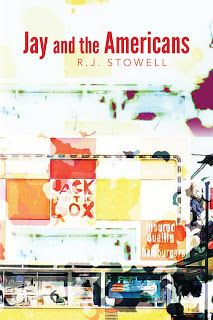 Tower Records was the first Southern California location of the Sacramento-based chain, and the most famous. Before Tower was built, the corner had been a drive-in restaurant in the '40s, a coffee shop in the '50s, and in 1964, Earl "Madman" Muntz sold car stereos there. I mentioned in a previous post that Moby Disc was 900 square feet; Tower was 8,660.
Tower Records was the first Southern California location of the Sacramento-based chain, and the most famous. Before Tower was built, the corner had been a drive-in restaurant in the '40s, a coffee shop in the '50s, and in 1964, Earl "Madman" Muntz sold car stereos there. I mentioned in a previous post that Moby Disc was 900 square feet; Tower was 8,660. The store's lengthy aisles with rows and rows of music were crowded with an eclectic group of hippies and elites searching for the next great find. And, unlike other stores, Tower Records stayed open until midnight—and 1 a.m. on the weekends—so you could shop late. The video shows a collage of the store and includes a glimpse of Elton John. I was off that day.
The following is a true story and a passage from my first novel, Jay and the Americans, available on Amazon or at the link in the sidebar. You can read Jay for free on Kindle Unlimited.
The next day my mother said with urgency, “Gather your things, let’s go.” I didn’t know what she meant; grown-ups talk so fast. I took a Beatles trading card, and my Tony the Tiger spoon, the things one values when five. We packed the Rambler, his car, and went to the White Front on Roscoe Blvd. where I single-handedly catapulted “Glad All Over” to No. 1 on the KHJ Boss-30.
The White Front had a 45 vending machine. I wanted “In My Room,” the B side to The Beach Boys’ “Be True to Your School.” I always liked the B sides. I pushed D12, my 45¢ clattered back into the change slot and out came “Glad All Over” by the Dave Clark Five. I tried again. A quarter, two dimes, “Glad All Over.” Soon a crowd of teens and would-be hippies gathered round, my mother and I passing out “Glad All Over” like samples at See’s Candies. It was the first time I’d seen my mother smile in a long while.
I looked at toys as my mother tried on stirrup pants. We bought incidentals on a White Front credit card with my father’s name, we ate hamburgers at Beeps and drove forever into the night; the forever when you’re five. Kneeling on the back seat, gazing out the rear window, I watched as the mindless golden glow of the Valley faded to black.
Published on January 30, 2020 05:42
January 29, 2020
The Great L.A. Record Stores - Part 1
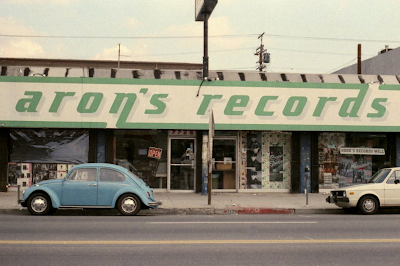 Having a family in the industry, music has been a part of my life since I can remember. My mother was a back-up singer, my father painted those famous rock billboards that lined the Sunset Strip. Obviously, it rubbed off; and today, as you may have surmised, I am the author of two (soon to be three) novels about L.A. with rock music as a character in each.
Having a family in the industry, music has been a part of my life since I can remember. My mother was a back-up singer, my father painted those famous rock billboards that lined the Sunset Strip. Obviously, it rubbed off; and today, as you may have surmised, I am the author of two (soon to be three) novels about L.A. with rock music as a character in each.Records became an obsession for me in the early 1970s. I bought my first LP, Sgt. Pepper, at the Licorice Pizza on Van Nuys Blvd. in Panorama City (1967). And my brother would take me down to Wallichs Music City in the middle of the night. We’d pick out records and take over one of the listening booths. I've recently posted about Sight and Sound in Van Nuys where I bought Richard Harris's (Dumbledore's) A Tramp Shining, with "MacArthur Park."
Across Victory Blvd., though, in the early 70s, opened Moby Disc. The store would become a small chain and my new wave years were spent at the location in Sherman Oaks across from Casa de Cadillac, but for this short series on L.A.'s record stores, it was the Moby on Victory that I remember most fondly. (Don't get me wrong, though, it was in Sherman Oaks that I first heard Elvis Costello!, Human League, and the B52s.)
The tiny 900 square foot space was the premiere store for progressive rock. It was there that I bought the progressive staples, Close to the Edge, the Yes solos, PFM, Camel, Renaissance, Aphrodite's Child, on and on.
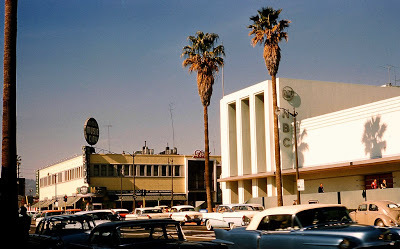 At Wallichs at Sunset and Vine and across Victory Blvd. at The House of Sight and Sound, there were listening booths. You’d grab a handful of records and spend hours under the headphones, but there was no such thing at Moby. Immediately upon entering on the right were the new releases. Across from that, with an aisle through which two people couldn’t fit, was the cash register and it was there, crowding the front of the store, that we'd gather and crank up whatever was new. There were times that ring so clearly in my head: the first time I heard Relayer and Gentle Giant’s Octopus, or "Hocus Pocus" by Focus. That era lasted for me from 1972 or so until I no longer had to take a bus anywhere (circa 1979). Before that, it was the 93 RTD bus that stopped right there in front of Moby.
At Wallichs at Sunset and Vine and across Victory Blvd. at The House of Sight and Sound, there were listening booths. You’d grab a handful of records and spend hours under the headphones, but there was no such thing at Moby. Immediately upon entering on the right were the new releases. Across from that, with an aisle through which two people couldn’t fit, was the cash register and it was there, crowding the front of the store, that we'd gather and crank up whatever was new. There were times that ring so clearly in my head: the first time I heard Relayer and Gentle Giant’s Octopus, or "Hocus Pocus" by Focus. That era lasted for me from 1972 or so until I no longer had to take a bus anywhere (circa 1979). Before that, it was the 93 RTD bus that stopped right there in front of Moby.As the millennium kicked in, vinyl began its collapse. While it had struggled amidst the promises of digital music with the CD, the vapid world of downloading began. Digital downloads are a lonely and sterile beast, unsatisfying to the soul. Worse, because of them, the album format died an untimely death.
 Because of them, stores like Aron's and Rhino shuttered their doors. And the new giants, like Amoeba in Hollywood, failed to fill the gap. Amoeba was like the Walmart of vinyl (I'll amend that to say that Amoeba today is a far more satisfying experience, but it's no Vinyl Fetish, that’s for sure).
Because of them, stores like Aron's and Rhino shuttered their doors. And the new giants, like Amoeba in Hollywood, failed to fill the gap. Amoeba was like the Walmart of vinyl (I'll amend that to say that Amoeba today is a far more satisfying experience, but it's no Vinyl Fetish, that’s for sure).For me, in the late 70s and early 80s, Aron's was a rite of passage. I was living in Hollywood, having shrugged off the Valley (sorry Moby Disc), and I'd wander over to Melrose. Aron's was there before Melrose was trendy, before Poseur and Cowboys and Poodles, maybe even before Aardvark and Flip. Then came Rene's All Ears, which was smaller and more intimate. I'd be lurking among the bins in my painter's pants and my cons flipping through the racks, the stack of $3.00 LPs getting bigger and bigger. I invested a lot of money and a lot of time.
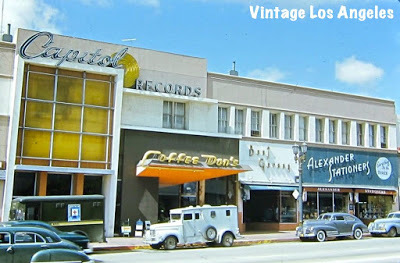 Just a Cool Pic of Capitol Records Pre-Tower. It Would Become Dot Records.
Just a Cool Pic of Capitol Records Pre-Tower. It Would Become Dot Records.Wallichs Was to the Left.By '81 or so, when the new wave kicked in, it was all about Vinyl Fetish, a more European-like venue with 12-inch import singles lining the walls in plastic sleeves. If you wanted something you’d point. At Aron's, I was more eclectic, everything from Lena Lovich to The Wall, but at Vinyl Fetish, it was all about The Cure, Blancmange, Haircut 100, and especially about New Order. It was there that I heard "Blue Monday" for the first time, the biggest selling 12-inch of all time. It was there that I first saw the video for "Girls on Film."
My collection of imports was, by 1983, over a thousand units. Honestly, if I had them today, I could buy a house. Indirectly, maybe I did. I was accepted at UCLA and then transferred to Rutgers College and unable to afford my education, I sold all my records back to Aron's. They bought the whole collection for $4300, enough for my first year as a Bruin.
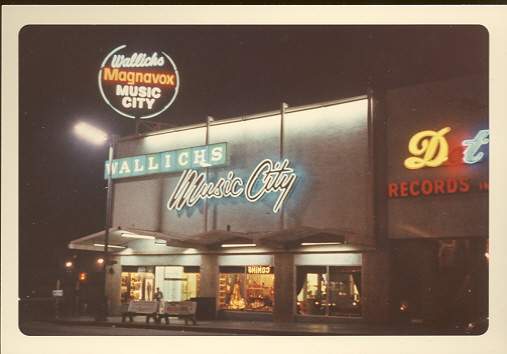
Published on January 29, 2020 05:13
January 27, 2020
The Masque - 40 Years Ago - Abandoned Places
 Retrospective: In Awe of Its BeautyI was at the Masque just once for half an hour. That's it. That's my history with L.A. punk, when push comes to shove. We were punky, trendy not punks - we were who punks beat up, the new wave (the next wave). We fit in with the Mods; we'd hang at the ON Club, get drunk enough to make an appearance at the Atomic Café or the Cathay de Grande, but our home was the Lhasa or down Hollywood Blvd. at the Seven Seas across from Grauman's Chinese. We were Orange Juice and Depeche Mode, Haircut 100; the Masque kids were Darby Crash, the Germs or the Circle Jerks. We may have even been friends - we'd end up at Danny's Oki Dog or Canter's Deli at 3am (a demilitarized zone) and share a hot pastrami with Zander Schloss (long as we paid - no one ever paid), but we didn't last long on their turf.
Retrospective: In Awe of Its BeautyI was at the Masque just once for half an hour. That's it. That's my history with L.A. punk, when push comes to shove. We were punky, trendy not punks - we were who punks beat up, the new wave (the next wave). We fit in with the Mods; we'd hang at the ON Club, get drunk enough to make an appearance at the Atomic Café or the Cathay de Grande, but our home was the Lhasa or down Hollywood Blvd. at the Seven Seas across from Grauman's Chinese. We were Orange Juice and Depeche Mode, Haircut 100; the Masque kids were Darby Crash, the Germs or the Circle Jerks. We may have even been friends - we'd end up at Danny's Oki Dog or Canter's Deli at 3am (a demilitarized zone) and share a hot pastrami with Zander Schloss (long as we paid - no one ever paid), but we didn't last long on their turf.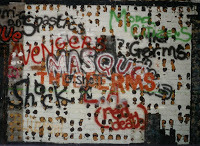 I went to high school with Belinda Carlisle out in Ventura County, as suburban as suburban gets. The Newbury Black and Gold. Belinda was a 10th grade cheerleader. By the time she was 19, she wouldn't talk to me anymore; I represented something to her. I was new wave and younger, and she was punk, yet we'd run into each other at the Aardvark or Flip (vintage clothing stores on Melrose), and when no one was looking she'd say, "Remember when..." I had a real respect for her.
I went to high school with Belinda Carlisle out in Ventura County, as suburban as suburban gets. The Newbury Black and Gold. Belinda was a 10th grade cheerleader. By the time she was 19, she wouldn't talk to me anymore; I represented something to her. I was new wave and younger, and she was punk, yet we'd run into each other at the Aardvark or Flip (vintage clothing stores on Melrose), and when no one was looking she'd say, "Remember when..." I had a real respect for her. 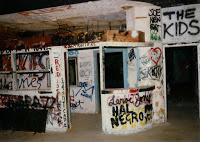
I couldn't be a punk. It took a rugged spunk I didn't possess. Indeed, my claustrophobia started at the Masque, just going down those steps - a dank stairwell that led down to a graffitied concrete basement with no way out. It smelled like sweat and piss. I don't know how she did it; she was this sweet thing. Twenty minutes on I got socked in the face when some nasty-ass skinhead started messing with Kenya. She turned around, looked at me and said, "You gonna let him talk to me like that?" Well, frankly, I was, but I can't now. can I? Ended up a war wound; I milked it; got lots of sympathy from the little new wave girls at the Seven Seas.
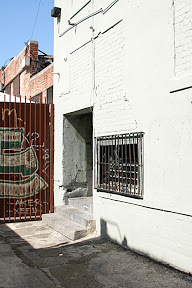 Entryway on CherokeeThe Masque opened August 18, 1977 on the southwest corner of Hollywood Boulevard and Cherokee (1665 N. Cherokee), the Pussycat theater next door. The club was owned and operated by Scottish expat Brendan Mullen. It was originally intended as a cheap rehearsal spot for Brendan and a place to live. Brendan quickly became the leader, like Fagan, to every kind of street urchin and ragamuffin that walked the streets of Hollywood Boulevard. By 1979 the club was closed. It wasn't my scene; that was yet to come, but it was a scene, a vital one, unforced, unabiding, The Masque just happened. This was pre-crack, pre-AIDS, pre-Reagan, back when things were allowed to just happen. In the way of tribute, the following is a list of the bands who graced the Masque in its short reign and in my absence: The Suburban Lawns, Black Randy and the Metrosquad, The Germs, Geza X, The Bags, The Screamers, The Weirdos, F-Word, The Motels and, of course, The Go-go's.
Entryway on CherokeeThe Masque opened August 18, 1977 on the southwest corner of Hollywood Boulevard and Cherokee (1665 N. Cherokee), the Pussycat theater next door. The club was owned and operated by Scottish expat Brendan Mullen. It was originally intended as a cheap rehearsal spot for Brendan and a place to live. Brendan quickly became the leader, like Fagan, to every kind of street urchin and ragamuffin that walked the streets of Hollywood Boulevard. By 1979 the club was closed. It wasn't my scene; that was yet to come, but it was a scene, a vital one, unforced, unabiding, The Masque just happened. This was pre-crack, pre-AIDS, pre-Reagan, back when things were allowed to just happen. In the way of tribute, the following is a list of the bands who graced the Masque in its short reign and in my absence: The Suburban Lawns, Black Randy and the Metrosquad, The Germs, Geza X, The Bags, The Screamers, The Weirdos, F-Word, The Motels and, of course, The Go-go's.Unlike bands like the Pistols, The Ramones, Siouxsie and The Clash, L.A. punk never had the same notoriety as those iterations in London or New York, but it was no less influential. There are few photos of The L.A. punk scene at the Masque, yet unlike The Mudd Club or CBGBs, what was the Masque remains pretty much intact. I remember the rank odor, the sticky floors and the punch in the eye, but I look at these photos, and there is a beauty there, a beauty that eluded me in '79; it's too bad. Sometimes you just have to wake up and smell the vomit.
A documentary film on the Masque is available here . For their video "Perfect," Smashing Pumpkins revisited the Masque, bringing it alive one last time. (Click the image below to see the vid.)
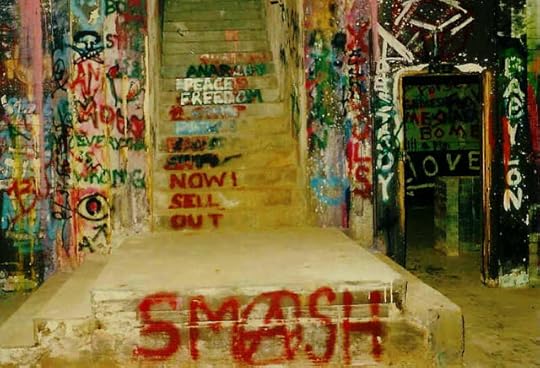 The Only Way Out is Through
The Only Way Out is Through
Published on January 27, 2020 05:26
Christmas Happening - Laguna Beach, California - Forgotten Festivals
In 1970, a cargo plane flew over 25,000 hippies and dropped thousands of acid tabs to the cheering revelers below. Postcards like the one below were jettisoned across Laguna Canyon, the catalyst for a crazed acid test held Christmas day. Each card had an insert for a tab of acid, Orange Sunshine to be specific. As shown, printed on the card were various Native American motifs, along with petroglyphs and symbols and the phrase, "May the Great Spirit watch over you as Long as the grass grows and the water flows." By mid-December 1970 word of mouth about the planned festivities had gotten around Orange County, then all over the L.A. area, and soon the rings spread outside California. No one knew exactly what was going to happen, yet in the post-Woodstock daze (and despite Altamont earlier that year), the locale and timing struck a chord among America's youth, who embarked on journeys from remote parts of the U.S. to join the Laguna Christmas party. It's worth noting that this occurred without the draw of any major rock music names; like the early San Francisco gatherings, the Happening wasn't a rock festival, but simply a "happening." This didn’t keep rumors about famous participants from spreading, perhaps fueled by the cunning arrangers. As the buzz became louder, the good towns-people were getting increasingly nervous.
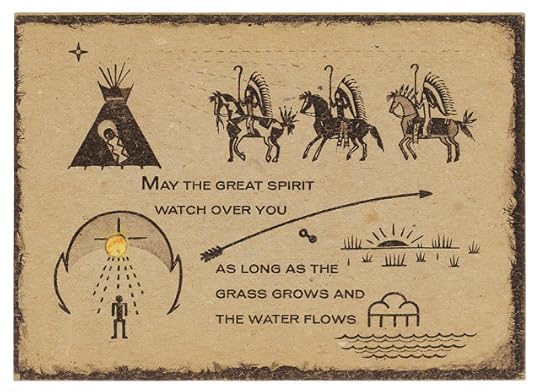 The Acid Postcard I found on eBay Last Week - Hands Off, It's Mine!
The Acid Postcard I found on eBay Last Week - Hands Off, It's Mine!
The event was described by local police as "heavy on drugs, nudity, fornication and general orgiastic chaos." Contraband was "strewn across the Southern California landscape; booze and acid ran through the gutters for dogs to drink," or so the story goes (AM tends to romanticize hippie culture, while the media despised it). The event was billed as a one-day event of peace, love and music, but after three days it had turned into much more; an estimated 25,000 people gathered in a field of sycamore and eucalyptus trees for what is known today as the Christmas Happening.
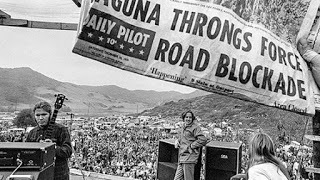 Despite massive traffic jams, freezing night temps and insufficient food, throngs of young people, Vietnam veterans and free spirits descended into the canyon near the intersection of Laguna Canyon and El Toro roads, evoking the scene a couple thousand miles away the year before. For participant Sunny Taylor-Colby, it was the best Christmas of her life. As she wandered amid the happening's So Cal vibe she felt something of an Aquarian spirit in the air: "I was 18 then and I had a wonderful time at that event with my boyfriend Bobby Lee Gregory. "I rode in on a bicycle's handlebars and it was just great. Everybody there was calm and awesome and beautiful and kind and sweet. Seriously, we were all mellow and chill." That is a memory worth its weight (anything in which one arrives on the handlebars of a bicycle is "mellow and chill; can we agree?).
Despite massive traffic jams, freezing night temps and insufficient food, throngs of young people, Vietnam veterans and free spirits descended into the canyon near the intersection of Laguna Canyon and El Toro roads, evoking the scene a couple thousand miles away the year before. For participant Sunny Taylor-Colby, it was the best Christmas of her life. As she wandered amid the happening's So Cal vibe she felt something of an Aquarian spirit in the air: "I was 18 then and I had a wonderful time at that event with my boyfriend Bobby Lee Gregory. "I rode in on a bicycle's handlebars and it was just great. Everybody there was calm and awesome and beautiful and kind and sweet. Seriously, we were all mellow and chill." That is a memory worth its weight (anything in which one arrives on the handlebars of a bicycle is "mellow and chill; can we agree?).
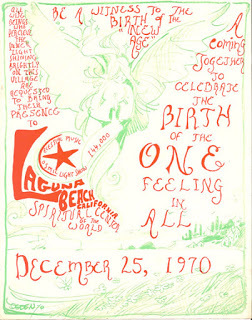 With the help of the Brotherhood of Eternal Love, an organization that dubbed itself "the Johnny Appleseeds of hallucinogenics," Orange Sunshine spread throughout the world. The Brotherhood's most dramatic display was there in Laguna that day; the nearly pure LSD25 derivative effectively riding in on a bike's handlebars - even better, littered across the sky, airmail, so to speak.
With the help of the Brotherhood of Eternal Love, an organization that dubbed itself "the Johnny Appleseeds of hallucinogenics," Orange Sunshine spread throughout the world. The Brotherhood's most dramatic display was there in Laguna that day; the nearly pure LSD25 derivative effectively riding in on a bike's handlebars - even better, littered across the sky, airmail, so to speak.
Orange Sunshine had become ubiquitous thanks primarily to psychedelic evangelist Tim Scully, who spent hours in the lab creating the drug at the heart of the 1960s counter-culture movement. In the 1960s and 70s, the Brotherhood of Eternal Love made good on its quest to spread LSD to the public. By the time its leading members were arrested in 1972, the psychedelic religion had single-handedly distributed millions of tablets of acid throughout Southern California. A hippie named John Griggs, aka "Farmer John," was the founding father of the movement which aimed to spread the gospel of LSD and psychedelics. That gospel was registered as a legally recognized, tax exempt, religious organization in October of 1966, soon after acid was made illegal in California.
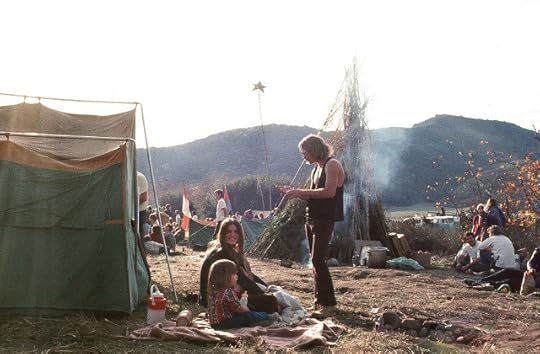
At first, Griggs' following was a small set happy to trip on the weekends and discuss future plans of running a commune together. When John learned of Timothy Leary's plans for the League of Spiritual Discovery, he decided to grow the Brotherhood into something similar. The new psychedelic religion's beliefs would center on spiritual freedom and the spread of LSD. The Brothers bought four white houses near the arts store in Laguna Beach and set about distributing pot and acid. They were soon moving hundreds of kilos of marijuana and acid to the bums, surfers, and hippies in the area. By 1967, the organization was transporting drugs cross country to New York and earning a huge payday while doing it.
As the Brotherhood's business ventures grew, Tim Scully, a sound equipment engineer for the Grateful Dead and an apprentice to LSD chemist Owsley Stanley, was forming his own ideas about acid. Like the Brotherhood, Scully believed that people became more gentle and more caring after tripping and had an idea that he could make the world a better place by distributing LSD to the masses.Together with chemist Nick Sand, Scully manufactured the Brotherhood's most recognizable brand of acid in a clandestine laboratory in California. In a little farmhouse in rural Sonoma County, the pair would make more than 3.6 million tablets of "Orange Sunshine," using a substance called ALD-52. The underground cooks soon joined forces with the Brotherhood to distribute the drug.
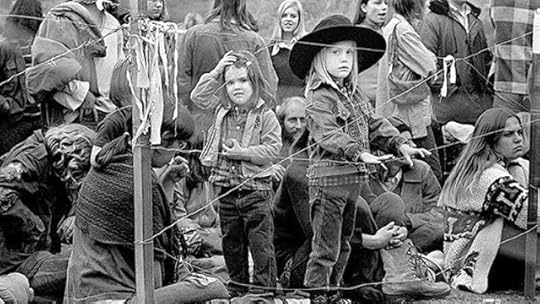 Distribution Members of the Brotherhood dispersed their trippy goods throughout California at Grateful Dead concerts, communes, love-ins, and the Altamont and Laguna festivals. The little orange tablets were so intertwined with the music scene of the era that Jimi Hendrix appeared in a Brotherhood film and performed a private show for its members.
Distribution Members of the Brotherhood dispersed their trippy goods throughout California at Grateful Dead concerts, communes, love-ins, and the Altamont and Laguna festivals. The little orange tablets were so intertwined with the music scene of the era that Jimi Hendrix appeared in a Brotherhood film and performed a private show for its members.
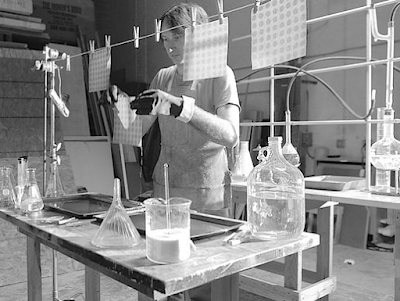 On Christmas Day, the "Laguna Greeter" (Eiler Larsen) welcomed the crowd to "Celebrate the birth of Jesus Christ." Local rock bands played and jammed, religious rituals and chants were performed, drugs were everywhere, homemade crafts were sold, and a baby or two was born. A typical rock gathering. Due to the make-shift arrangements, food and water supplies ran low, although the Hare Krishnas provided macrobiotic meals as best they could, and other locals brought turkey and hams in the spirit of the season.
On Christmas Day, the "Laguna Greeter" (Eiler Larsen) welcomed the crowd to "Celebrate the birth of Jesus Christ." Local rock bands played and jammed, religious rituals and chants were performed, drugs were everywhere, homemade crafts were sold, and a baby or two was born. A typical rock gathering. Due to the make-shift arrangements, food and water supplies ran low, although the Hare Krishnas provided macrobiotic meals as best they could, and other locals brought turkey and hams in the spirit of the season.
Pressured by the larger than expected freak invasion, police sealed off the roads to and from the entire Laguna Beach district and allowed only emergency traffic and local residents through. Various solutions including off-road adventures up and down the hills with supplies of rice and water were devised by the festival crew. A medical tent had been erected, equipped with two volunteer doctors, some stretchers, and little else. The LA Times reported that "A spokesman for the Laguna Beach Free Clinic said several hundred persons were treated for everything from snake bites to a broken leg and drug overdoses."
There was no Altamont-like violence, although the usual amount of freakouts and bad trips occurred. An amusing snapshot was offered when the MC announced from the stage: "We got to have some Thorazine at the medical tent immediately, some guy drank a whole bottle of acid. I need some Thorazine up here too."
Altamont in many ways signaled the end of the utopian air provided large scale outdoor concerts, but the Christmas Happening proved that the hippie era may have evolved with the advent of the 70s, but it had only just begun.
 The Acid Postcard I found on eBay Last Week - Hands Off, It's Mine!
The Acid Postcard I found on eBay Last Week - Hands Off, It's Mine!The event was described by local police as "heavy on drugs, nudity, fornication and general orgiastic chaos." Contraband was "strewn across the Southern California landscape; booze and acid ran through the gutters for dogs to drink," or so the story goes (AM tends to romanticize hippie culture, while the media despised it). The event was billed as a one-day event of peace, love and music, but after three days it had turned into much more; an estimated 25,000 people gathered in a field of sycamore and eucalyptus trees for what is known today as the Christmas Happening.
 Despite massive traffic jams, freezing night temps and insufficient food, throngs of young people, Vietnam veterans and free spirits descended into the canyon near the intersection of Laguna Canyon and El Toro roads, evoking the scene a couple thousand miles away the year before. For participant Sunny Taylor-Colby, it was the best Christmas of her life. As she wandered amid the happening's So Cal vibe she felt something of an Aquarian spirit in the air: "I was 18 then and I had a wonderful time at that event with my boyfriend Bobby Lee Gregory. "I rode in on a bicycle's handlebars and it was just great. Everybody there was calm and awesome and beautiful and kind and sweet. Seriously, we were all mellow and chill." That is a memory worth its weight (anything in which one arrives on the handlebars of a bicycle is "mellow and chill; can we agree?).
Despite massive traffic jams, freezing night temps and insufficient food, throngs of young people, Vietnam veterans and free spirits descended into the canyon near the intersection of Laguna Canyon and El Toro roads, evoking the scene a couple thousand miles away the year before. For participant Sunny Taylor-Colby, it was the best Christmas of her life. As she wandered amid the happening's So Cal vibe she felt something of an Aquarian spirit in the air: "I was 18 then and I had a wonderful time at that event with my boyfriend Bobby Lee Gregory. "I rode in on a bicycle's handlebars and it was just great. Everybody there was calm and awesome and beautiful and kind and sweet. Seriously, we were all mellow and chill." That is a memory worth its weight (anything in which one arrives on the handlebars of a bicycle is "mellow and chill; can we agree?). With the help of the Brotherhood of Eternal Love, an organization that dubbed itself "the Johnny Appleseeds of hallucinogenics," Orange Sunshine spread throughout the world. The Brotherhood's most dramatic display was there in Laguna that day; the nearly pure LSD25 derivative effectively riding in on a bike's handlebars - even better, littered across the sky, airmail, so to speak.
With the help of the Brotherhood of Eternal Love, an organization that dubbed itself "the Johnny Appleseeds of hallucinogenics," Orange Sunshine spread throughout the world. The Brotherhood's most dramatic display was there in Laguna that day; the nearly pure LSD25 derivative effectively riding in on a bike's handlebars - even better, littered across the sky, airmail, so to speak. Orange Sunshine had become ubiquitous thanks primarily to psychedelic evangelist Tim Scully, who spent hours in the lab creating the drug at the heart of the 1960s counter-culture movement. In the 1960s and 70s, the Brotherhood of Eternal Love made good on its quest to spread LSD to the public. By the time its leading members were arrested in 1972, the psychedelic religion had single-handedly distributed millions of tablets of acid throughout Southern California. A hippie named John Griggs, aka "Farmer John," was the founding father of the movement which aimed to spread the gospel of LSD and psychedelics. That gospel was registered as a legally recognized, tax exempt, religious organization in October of 1966, soon after acid was made illegal in California.

At first, Griggs' following was a small set happy to trip on the weekends and discuss future plans of running a commune together. When John learned of Timothy Leary's plans for the League of Spiritual Discovery, he decided to grow the Brotherhood into something similar. The new psychedelic religion's beliefs would center on spiritual freedom and the spread of LSD. The Brothers bought four white houses near the arts store in Laguna Beach and set about distributing pot and acid. They were soon moving hundreds of kilos of marijuana and acid to the bums, surfers, and hippies in the area. By 1967, the organization was transporting drugs cross country to New York and earning a huge payday while doing it.
As the Brotherhood's business ventures grew, Tim Scully, a sound equipment engineer for the Grateful Dead and an apprentice to LSD chemist Owsley Stanley, was forming his own ideas about acid. Like the Brotherhood, Scully believed that people became more gentle and more caring after tripping and had an idea that he could make the world a better place by distributing LSD to the masses.Together with chemist Nick Sand, Scully manufactured the Brotherhood's most recognizable brand of acid in a clandestine laboratory in California. In a little farmhouse in rural Sonoma County, the pair would make more than 3.6 million tablets of "Orange Sunshine," using a substance called ALD-52. The underground cooks soon joined forces with the Brotherhood to distribute the drug.
 Distribution Members of the Brotherhood dispersed their trippy goods throughout California at Grateful Dead concerts, communes, love-ins, and the Altamont and Laguna festivals. The little orange tablets were so intertwined with the music scene of the era that Jimi Hendrix appeared in a Brotherhood film and performed a private show for its members.
Distribution Members of the Brotherhood dispersed their trippy goods throughout California at Grateful Dead concerts, communes, love-ins, and the Altamont and Laguna festivals. The little orange tablets were so intertwined with the music scene of the era that Jimi Hendrix appeared in a Brotherhood film and performed a private show for its members.  On Christmas Day, the "Laguna Greeter" (Eiler Larsen) welcomed the crowd to "Celebrate the birth of Jesus Christ." Local rock bands played and jammed, religious rituals and chants were performed, drugs were everywhere, homemade crafts were sold, and a baby or two was born. A typical rock gathering. Due to the make-shift arrangements, food and water supplies ran low, although the Hare Krishnas provided macrobiotic meals as best they could, and other locals brought turkey and hams in the spirit of the season.
On Christmas Day, the "Laguna Greeter" (Eiler Larsen) welcomed the crowd to "Celebrate the birth of Jesus Christ." Local rock bands played and jammed, religious rituals and chants were performed, drugs were everywhere, homemade crafts were sold, and a baby or two was born. A typical rock gathering. Due to the make-shift arrangements, food and water supplies ran low, although the Hare Krishnas provided macrobiotic meals as best they could, and other locals brought turkey and hams in the spirit of the season.Pressured by the larger than expected freak invasion, police sealed off the roads to and from the entire Laguna Beach district and allowed only emergency traffic and local residents through. Various solutions including off-road adventures up and down the hills with supplies of rice and water were devised by the festival crew. A medical tent had been erected, equipped with two volunteer doctors, some stretchers, and little else. The LA Times reported that "A spokesman for the Laguna Beach Free Clinic said several hundred persons were treated for everything from snake bites to a broken leg and drug overdoses."
There was no Altamont-like violence, although the usual amount of freakouts and bad trips occurred. An amusing snapshot was offered when the MC announced from the stage: "We got to have some Thorazine at the medical tent immediately, some guy drank a whole bottle of acid. I need some Thorazine up here too."
Altamont in many ways signaled the end of the utopian air provided large scale outdoor concerts, but the Christmas Happening proved that the hippie era may have evolved with the advent of the 70s, but it had only just begun.
Published on January 27, 2020 05:26
January 25, 2020
Fantasy Fair and Magic Mountain Music Festival - More of the Forgotten Festivals
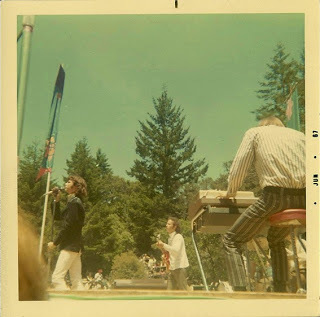 The DoorsRevisionists will insist that Betsy Ross had nothing to do with anything, that Malcolm X was a compassionate humanitarian, and that Monterey Pop was not the first of the great rock festivals. Instead, despite the fact that it has slipped the collective mind, and to appease the contrarians, let the record show that the KFRC Fantasy Fair and Magic Mountain Music Festival was held June 10th and 11th, 1967 at the Sidney B. Cushing Memorial Amphitheatre, high on the south face of Mount Tamalpais, Marin County, California, two full weeks before Monterey. Kicking off the Summer of Love, 36,000 people attended Fantasy Fair, the two-day concert and festival influenced by the popular Renaissance Pleasure Faire. Admission to the festival was a measly two bucks and all proceeds were donated to the Hunters Point Child Care Center in San Francisco. Fantasy Fair was originally scheduled for June 3rd and 4th, but was delayed due to inclement weather.
The DoorsRevisionists will insist that Betsy Ross had nothing to do with anything, that Malcolm X was a compassionate humanitarian, and that Monterey Pop was not the first of the great rock festivals. Instead, despite the fact that it has slipped the collective mind, and to appease the contrarians, let the record show that the KFRC Fantasy Fair and Magic Mountain Music Festival was held June 10th and 11th, 1967 at the Sidney B. Cushing Memorial Amphitheatre, high on the south face of Mount Tamalpais, Marin County, California, two full weeks before Monterey. Kicking off the Summer of Love, 36,000 people attended Fantasy Fair, the two-day concert and festival influenced by the popular Renaissance Pleasure Faire. Admission to the festival was a measly two bucks and all proceeds were donated to the Hunters Point Child Care Center in San Francisco. Fantasy Fair was originally scheduled for June 3rd and 4th, but was delayed due to inclement weather.
 Morrison
MorrisonLet it be known that nothing occurs in a vacuum and Fantasy Fair was the first of modern rock festivals (unless one includes [insert venue/event here]. Indeed it was a major and evolutionary gathering that featured The Doors, The Byrds, Jefferson Airplane, Canned Heat, Spanky and Our Gang, Captain Beefheart, The Seeds, The Grass Roots, Tim Buckley, Country Joe and the Fish and The 5th Dimension. [Several acts booked for the original dates were unable to perform, including the 13th Floor Elevators and Smoky Robinson.] The moral of the story, '67 was indeed sublime.
Admission to the festival was $2 and all proceeds were donated to nearby Hunter's Point Child Care Center in San Francisco. The Festival was originally scheduled for June 3rd and 4th but was rescheduled due to inclement weather. After enjoying a scenic ride up the mountain from points such as the Marin Civic Center and Mill Valley, a giant Buddha balloon greeted attendees when they arrived. Transportation was provided by "Trans Love Bus Lines."
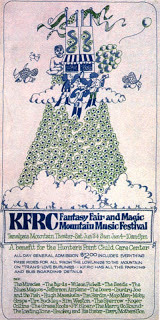 The Official Program copy read: "A Benefit for the Hunters Point Child Care Centers - A gathering of beautiful things, created and collected by the artisians and craftsmen of Northern California, and represented by the exhibitors listed on the Fantasy Fair Map - a variety of "happenings." When you arrive at the Fantasy Fair, you will immediately surrounded by color and motion, the good vibrations of thousands of people flowing with the natural beauty of Mt. Tamalpais. The major happening is you, your feeling of good will, and your knowledge that the Fair and the Mountain are a part of you, therefore yours to enjoy. The woods and meadows are an open invitation to wander and enjoy yourself to the limits of your imagination. And because they are yours to enjoy, we hope that you will grove with the surroundings, doing everything you can to keep them in their natural state - For your enjoyment, The Fantasy Fair staff has prepared the Geodesic Dome Light Chamber. The Dome can accomadate 150 people per 8 minute show. We invite your participation in the wonders of the Dome, and ask that at the end of each show, you move out to make room for others waiting on line. You are also invited to enloy the giant slide, the tree swings (on the way to the valley of dancing), the vast assortment of strolling or sitting musicians (find many of them under trees or rocks), and other suprises prepared by Fantasy Fair volunteers for your pleasure and participation - Music will be performed hourly in the Amphitheatre from 8am until 6pm. We ask that after each performance the seats be cleared to make way for people that may be waiting for the next performance- The Fantasy Fair wishes to express extreme gratitude to the artists in the performing groups, who have graciously donated their valuable time and exceptional talents, and all the bands performing in the Valley of Dancing.
The Official Program copy read: "A Benefit for the Hunters Point Child Care Centers - A gathering of beautiful things, created and collected by the artisians and craftsmen of Northern California, and represented by the exhibitors listed on the Fantasy Fair Map - a variety of "happenings." When you arrive at the Fantasy Fair, you will immediately surrounded by color and motion, the good vibrations of thousands of people flowing with the natural beauty of Mt. Tamalpais. The major happening is you, your feeling of good will, and your knowledge that the Fair and the Mountain are a part of you, therefore yours to enjoy. The woods and meadows are an open invitation to wander and enjoy yourself to the limits of your imagination. And because they are yours to enjoy, we hope that you will grove with the surroundings, doing everything you can to keep them in their natural state - For your enjoyment, The Fantasy Fair staff has prepared the Geodesic Dome Light Chamber. The Dome can accomadate 150 people per 8 minute show. We invite your participation in the wonders of the Dome, and ask that at the end of each show, you move out to make room for others waiting on line. You are also invited to enloy the giant slide, the tree swings (on the way to the valley of dancing), the vast assortment of strolling or sitting musicians (find many of them under trees or rocks), and other suprises prepared by Fantasy Fair volunteers for your pleasure and participation - Music will be performed hourly in the Amphitheatre from 8am until 6pm. We ask that after each performance the seats be cleared to make way for people that may be waiting for the next performance- The Fantasy Fair wishes to express extreme gratitude to the artists in the performing groups, who have graciously donated their valuable time and exceptional talents, and all the bands performing in the Valley of Dancing.Those of you who have read Jay and the Americans know that I got lost amongst the crowd on the Magic Mountain. I was nine years old, a fledgling hippie.
Jay and the Americans is available all over the world!
Buy Your Copy Today! Click the link below.
CreateSpace - Amazon - Amazon UK - Amazon France - Amazon Russia

Published on January 25, 2020 07:23
January 19, 2020
Newport Pop - The Forgotten Festivals
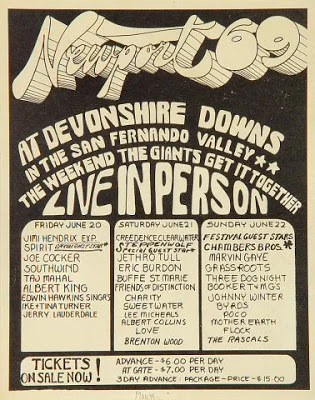 In 1968 and 1969 there were two seminal rock festivals that have barely ever gotten coverage; indeed, most people don’t even know that they existed, unless, of course, you were there, and even then… The first Newport Pop was held in Cosa Mesa at the Orange County Fairgrounds. A two-day event that featured a very young Alice Cooper, Canned Heat, the Chambers Brothers, Country Joe and the Fish, Sonny and Cher and Steppenwolf. Day two was Jefferson Airplane, The Grateful Dead, Jethro Tull, Quicksilver, Iron Butterfly and Blue Cheer. Despite its relative obscurity, the 1968 festival had attendance of over 100,000 during the two days.
In 1968 and 1969 there were two seminal rock festivals that have barely ever gotten coverage; indeed, most people don’t even know that they existed, unless, of course, you were there, and even then… The first Newport Pop was held in Cosa Mesa at the Orange County Fairgrounds. A two-day event that featured a very young Alice Cooper, Canned Heat, the Chambers Brothers, Country Joe and the Fish, Sonny and Cher and Steppenwolf. Day two was Jefferson Airplane, The Grateful Dead, Jethro Tull, Quicksilver, Iron Butterfly and Blue Cheer. Despite its relative obscurity, the 1968 festival had attendance of over 100,000 during the two days. Attendee: Day 1: "The opening act was an unheard-of 'chick group' called Alice Cooper. It wasn't till months later that we realized that Alice was a guy. … I recall Tiny Tim or Sonny and Cher, or perhaps both, getting booed off the stage."
Attendee: Day 2: "Blue Cheer destroyed their equipment (ala The Who) and people were getting out of hand. Humble Harve (the promoter) came on stage to ask kids to calm down but he was shouted off the stage with vulgar comments. He was devastated at not being deemed 'cool.'"
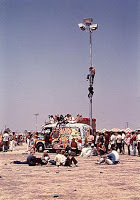 Attendee: Day 2: "Just as things were reaching the boiling point, Country Joe came on stage and told everybody to 'sit the fuck down.' It worked. Immediately everybody, from front to back, sat down.”
Attendee: Day 2: "Just as things were reaching the boiling point, Country Joe came on stage and told everybody to 'sit the fuck down.' It worked. Immediately everybody, from front to back, sat down.”The next year, at Devonshire Downs in Northridge in the San Fernando Valley, was the follow-up event with a crowd that, for the day, held within Devonshire Downs' confines 1/5 of the Valley's population (200,000 attendees). Many of the same bands were there, particularly the top names, but also Jimi Hendrix, Joe Cocker, Spirit, Marvin Gaye, The Rascals, Tiny Tim, Johnny Winter and The Grass Roots. Not bad for a venue and a festival of which no one has ever heard. There is little history about the shows and even fewer photos; Woodstock/Monterey Pop they were not.
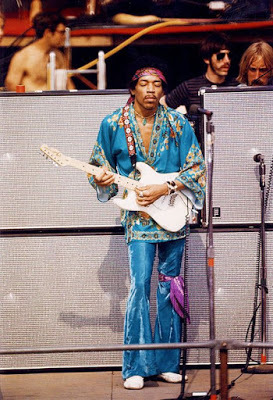 It wasn't a haven of peace and love the way Woodstock would turn out; indeed there was minor rioting and a somewhat tense presence by the Hell's Angels (as a security force), and Jimi's performance on day one was lackluster at best: "I think someone spiked Jimi," said Experience drummer Mitch Mitchell in Johnny Black's Eyewitness Hendrix book. "Or maybe he'd taken something of his own and then someone had spiked him on top of that. It was a disaster. I kept thinking, 'This is weird, all this money…' One of the worst gigs we ever played."
It wasn't a haven of peace and love the way Woodstock would turn out; indeed there was minor rioting and a somewhat tense presence by the Hell's Angels (as a security force), and Jimi's performance on day one was lackluster at best: "I think someone spiked Jimi," said Experience drummer Mitch Mitchell in Johnny Black's Eyewitness Hendrix book. "Or maybe he'd taken something of his own and then someone had spiked him on top of that. It was a disaster. I kept thinking, 'This is weird, all this money…' One of the worst gigs we ever played."Happily, that prompted the band's return for the festival's Sunday night closer, in a two-hour show featuring Eric Burdon, Buddy Miles and others that, conversely, passed into folklore as one of the group's landmarks. Los Angeles Times critic Pete Johnson was moved to write that the audience "may have heard the best performance of their lives."
Published on January 19, 2020 12:54
January 15, 2020
What were they up to in 1970?
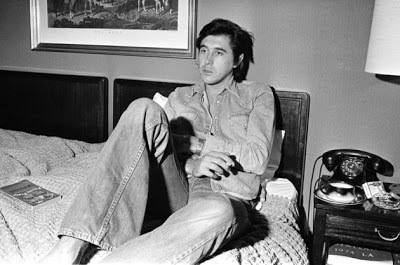 So many incredible bands and artists got their start in the late 60s and early 70s. 1969 saw the first LPs from Led Zeppelin, Badfinger, New Riders of the Purple Sage, Hall and Oates, Faces, Crazy Horse, King Crimson and Kraftwerk. 1970 saw the first recordings by Supertramp, Leon Russell, Emerson, Lake and Palmer, Stephen Stills, Sparks, and Black Sabbath. We don't have to dig too deeply to see where things were going. But how about those artists who weren't yet a blip on the horizon?
So many incredible bands and artists got their start in the late 60s and early 70s. 1969 saw the first LPs from Led Zeppelin, Badfinger, New Riders of the Purple Sage, Hall and Oates, Faces, Crazy Horse, King Crimson and Kraftwerk. 1970 saw the first recordings by Supertramp, Leon Russell, Emerson, Lake and Palmer, Stephen Stills, Sparks, and Black Sabbath. We don't have to dig too deeply to see where things were going. But how about those artists who weren't yet a blip on the horizon?In early 1970, Patti Smith was dating Robert Mapplethorpe, living in the Hotel Chelsea and writing and performing. She would often be seen with Mapplethorpe at CBGB's and at Max's Kansas City.
Bryan Ferry was performing occasionally, but, as many of us have to do, he was forced to work for a living. In Bryan's case, he was teaching pottery at the Holland Park School. He would form Roxy Music in November 1970.
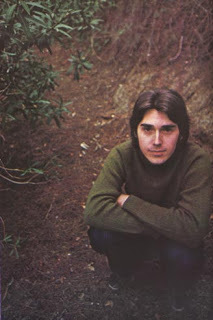 Stephen Morrissey was just a lad but he had already started a campaign of writing to Smash Hits and other British music magazines with his opinions. Some things don't change.
Stephen Morrissey was just a lad but he had already started a campaign of writing to Smash Hits and other British music magazines with his opinions. Some things don't change.Walter Becker and Donald Fagen met in 1967 and moved to Brooklyn in 1970 where they spent a year trying to sell their songs and themselves to the Brill Building set. It was Kenny Vance of Jay and the Americans who gave them a shot. They played with Jay and the Americans on tour for a hundred dollars per night. Other artists would start to perform their songs, such as Barbra Streisand, but it would be in 1970 that friend and associate of Kenny Vance, Gary Katz, would move to L.A. and hire Becker and Fagen as songwriters for ABC Records. Katz would go on to produce most of Steely Dan's LPs.
Glenn Frey of Long Branch Pennywhistle, alongside J.D. Souther met Don Henley in the spring of 1970. The relationship that would encompass Eagles (official name; not The Eagles) would last until 1980.
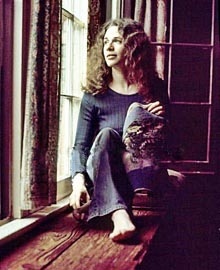 For his 1970 cult-classic, self-titled album, Emitt Rhodes recorded in a makeshift recording studio he set up at home in his bedroom. Rhodes taped the instruments on a four-track recorder.
For his 1970 cult-classic, self-titled album, Emitt Rhodes recorded in a makeshift recording studio he set up at home in his bedroom. Rhodes taped the instruments on a four-track recorder.Marvin Gaye was composing the compositions for this writer's number 1 soul/pop LP, What's Going On. Without it, there would be no Innervisions, no Superfly, it was that influential.
There was indeed a lot going on that is difficult to research but fun to speculate. Imagine, as we speak, 50 years ago, Carole King and Joni Mitchell sitting with their pianos (or Joni most likely her guitar) writing the songs that would become Tapestry and Blue. Not hard to get that visual.
Published on January 15, 2020 13:04
January 14, 2020
Sound City
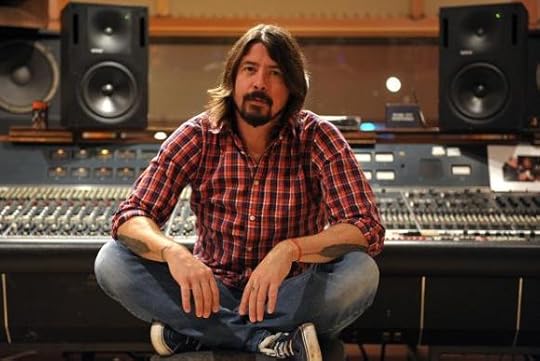 Sound City Studios was/is a recording studio incorporated in 1969, located down the street from an apartment my parent's managed in Van Nuys, California, and across the freeway from the now defunct Busch Gardens. The facility was formerly a production facility for the British amp manufacturer, Vox.
Sound City Studios was/is a recording studio incorporated in 1969, located down the street from an apartment my parent's managed in Van Nuys, California, and across the freeway from the now defunct Busch Gardens. The facility was formerly a production facility for the British amp manufacturer, Vox.Sound City contributed its signature analog sound to more than a hundred certified gold and platinum LPs. The studio was privately held from 1970, until it closed its commercial studio services in May 2011. Dave Grohl, former Nirvana drummer and current frontman for the Foo Fighters, purchased the Neve Electronics 8028 Console from Studio A, installing it in his private recording studio (and producing an amazing documentary of the studio). Sound City reopened 2016 with a completely renovated facility, but it's the history that concerns AM, particularly since I grew up just down the street.
In 1969, Sound City hosted the David Briggs productions Twelve Dreams of Dr. Sardonicus by Spirit and After the Gold Rush by Neil Young. Not a bad start, to say the least; Gold Rush arguably Neil's finest moment. On a more infamous note, cult leader Charles Manson made some recordings in Studio B, just a few months before the Manson family crime spree in the Summer of 1969.
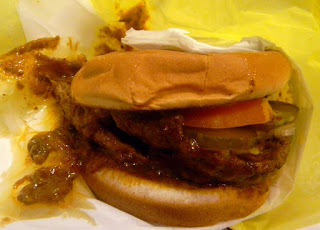 In the 1970s, Neil Young, Dr. John, Spirit, Crazy Horse, Nitty Gritty Dirt Band, Fleetwood Mac, and Leon Russell all recorded at the studio, and in 1974, Sound City championed a new artist from Gainesville, Florida, Tom Petty who recorded with a band called Mudcrunch. Petty would go on to have a 30-year relationship with the studio. Other artists who recorded at Sound City over the years include Foreigner, The Black Crowes, Johnny Cash (Unchained, 1996), Dio and the Red Hot Chili Peppers. Most famously, Nirvana’s Nevermind ranks up there with Weezer's Pinkerton, Death Cab for Cutie's Codes and Keys, The Dead's Terrapin Station and Elton John's Caribou.
In the 1970s, Neil Young, Dr. John, Spirit, Crazy Horse, Nitty Gritty Dirt Band, Fleetwood Mac, and Leon Russell all recorded at the studio, and in 1974, Sound City championed a new artist from Gainesville, Florida, Tom Petty who recorded with a band called Mudcrunch. Petty would go on to have a 30-year relationship with the studio. Other artists who recorded at Sound City over the years include Foreigner, The Black Crowes, Johnny Cash (Unchained, 1996), Dio and the Red Hot Chili Peppers. Most famously, Nirvana’s Nevermind ranks up there with Weezer's Pinkerton, Death Cab for Cutie's Codes and Keys, The Dead's Terrapin Station and Elton John's Caribou.In 1974, during the recording of Caribou, Elton John reportedly visited a nearby Tommy's Hamburgers for a chili-burger. The next day, the bitch was back for another. Stevie Nicks and Lindsey Buckingham enjoyed Howard Johnson's instead, right up Roscoe Blvd.
Addendum: A follower has pointed out that all records, with the exception of those from Sound City and select other sites, point to Caribou as being recorded at Caribou Ranch Studios in Nederland, Colorado. In his bio, Elton complained about the altitude and its effect on his voice, and so I am not quite certain the role Sound City played in the LP's production. Still, it's a great story. If someone has some insight, please let us know.
Published on January 14, 2020 04:39
January 10, 2020
Miles and Miles and Miles and Miles and Miles
"It's 50 years since Woodstock. If you were there, they say you won't remember. I remember..."
Miles From Nowhere is a hippie pilgrimage, the journey of a young man in poor health hoping to join the half-million strong. Recovering from kidney failure, Miles is hell-bent on Woodstock. After his father, Miles' transplant donor, succumbs to complications, Miles takes that long trek across the country, from California to New York, but the country gets in the way. In it, he finds love and lust, forgiveness, acceptance, communists, saints and sinners. Spoiler, Miles makes it to Woodstock, but only in time for Hendrix. Like all of us, you know, it's all about the journey.
But what would the journey be without music? The rock 'n' roll of 50 years ago, from Hendrix to the Who to Otis Redding, is like a character in the novel, a soundtrack in words. Travel across the country with Miles and his hippie entourage, all the while singing about the rain and love and peace.
In March this year, RJ Stowell's new novel, Calif., will be released. It's the follow-up to Miles From Nowhere. Get Miles in the meantime!
Get your copy of Miles From Nowhere, available on Amazon. Click here to order.
For a personalized copy, contact AM at rjsomeone@gmail.com.
Published on January 10, 2020 05:46
January 9, 2020
Laurel Canyon
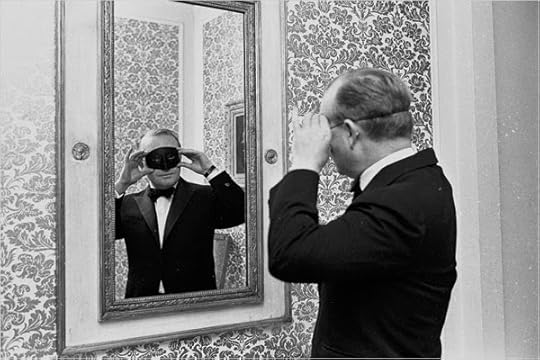 Truman CapoteTruman Capote's Black and White Ball in 1966 was the most famous party of all time. Among the 500 guests were Richard Avedon, Irving Berlin, Leonard Bernstein, Noël Coward, Mia Farrow, Henry Fonda, Philip Johnson, Robert F. Kennedy, Harper Lee, Jack Lemmon, Alan Jay Lerner, Shirley MacLaine, Norman Mailer, Mike Nichols, Gregory Peck, George Plimpton, Lee Radziwill, Philip Roth, Frank Sinatra, John Steinbeck, Andy Warhol, Tennessee Williams. It was like one of Gatsby's parties. So much anticipation went into Capote's planning that by the time the soiree arrived, it didn't matter anymore. They say that Truman made 500 friends and 15,000 enemies. Conversely, in L.A. fabulous parties, from The Beatles at Benedict Canyon to The VU at the Castle, went relatively unnoticed.
Truman CapoteTruman Capote's Black and White Ball in 1966 was the most famous party of all time. Among the 500 guests were Richard Avedon, Irving Berlin, Leonard Bernstein, Noël Coward, Mia Farrow, Henry Fonda, Philip Johnson, Robert F. Kennedy, Harper Lee, Jack Lemmon, Alan Jay Lerner, Shirley MacLaine, Norman Mailer, Mike Nichols, Gregory Peck, George Plimpton, Lee Radziwill, Philip Roth, Frank Sinatra, John Steinbeck, Andy Warhol, Tennessee Williams. It was like one of Gatsby's parties. So much anticipation went into Capote's planning that by the time the soiree arrived, it didn't matter anymore. They say that Truman made 500 friends and 15,000 enemies. Conversely, in L.A. fabulous parties, from The Beatles at Benedict Canyon to The VU at the Castle, went relatively unnoticed.  Peter TorkIn 1967, Lee Hazelwood, famous Hollywood manager and artist in his own right, threw the Bee Gees a party for their Hollywood shows. All of the beautiful people were there: The Bee Gees (of course), Ann Moses from Tiger Beat Magazine, Tommy Smothers, Buddy Rich, Angela Cartwright (Lost in Space, Sound of Music) who was only 17, Rodney Bingenheimer, Micky Dolenz, Davy Jones, and others. Not quite Truman's guest list, but ever more fascinating.
Peter TorkIn 1967, Lee Hazelwood, famous Hollywood manager and artist in his own right, threw the Bee Gees a party for their Hollywood shows. All of the beautiful people were there: The Bee Gees (of course), Ann Moses from Tiger Beat Magazine, Tommy Smothers, Buddy Rich, Angela Cartwright (Lost in Space, Sound of Music) who was only 17, Rodney Bingenheimer, Micky Dolenz, Davy Jones, and others. Not quite Truman's guest list, but ever more fascinating.  Mickey Dolenz
Mickey DolenzNo one truly recalls Tiny Tim's impact, yet the falsetto singer performed his first concert in Hollywood in the Summer of 1968 and 93KHJ invited tons of insiders to the after-party. Anyone who was anyone in the late 60s Hollywood scene attended, including Sajid Khan, George Takei and Walter Koenig from Star Trek, Don Steele, Andy Prine, Brenda Scott, Sally Field, Jimmy Webb, Peter Tork, Desi Arnez Jr, Dennis and Carl Wilson, and Annie Hinsche.
Dino Martin, the first son of legendary crooner Dean Martin, and band member of Dino, Desi and Billy, turned 16 in February 1968. Of course his father had to throw him a spectacular party. All of the young music/Hollywood crowd, the rat pack crowd, everyone: Desi Arnez Jr. and Billy Hinsche, Dean Martin, Davy Jones (Deana Martin's date), Stuart Whiting, Tony Curtis, Frank Sinatra and his wife, Mia Farrow, Tina Sinatra and Lucille Ball. After Dino's party, John and Michelle Phillips threw an after-party which was decidedly more hip than Dino's birthday. Many from Dean’s soiree were there in addition to Judy Collins, Donovan, Tommy Boyce, the Monkees, The Hollies, Eric Burdon and the Animals, The Who, and the Association all showed up and got really really high. Of course.
Mike Nesmith rarely threw parties; the exception was a celebration of the release of his first solo LP, Wichita Train Whistle Songs. The guest list included the other Monkees, Tommy Boyce, Bobby Hart, Stan Kenton, Bert Schneider, Bob Rafelson, Jack Nicholson and Bobby Darin.
 New York had Truman Capote who obsessed over his one big affair. Hollywood conversely had Peter Tork, whose parties were infamous. A 1968 event was reported in Tiger Beat magazine. The guest list included the other Monkee party animal, Micky Dolenz, Samantha Juste, David Crosby, Graham Nash, and Jimi Hendrix. The most famous was the July 4th shebang that Peter threw for Harvey Brooks of the Electric Flag. Guests included The Who, Mama Cass and John Sebastian of the Lovin' Spoonful. Yet throughout 1967 and '68 it was as if the parties at Peter's were but a stream of people in and out. Jackson Browne hung out at Tork's house during 1968: "These beautiful chicks from Peter Tork's house kept coming over with these big bowls of fruit and dope and shit. They'd fuck us in the pool. We'd wake up and see this beautiful sixteen year old flower child who knew how to say ‘fave rave’ with a bowl of fruit. She'd get you incredibly high and then take you downstairs to go swimming." Doug Trevor, of the Australian group, The Cherokees, also remembers Tork's house: "There were stoned hippies laying all over the place, naked girls wandering in and out of the pool and the constant noise of Peter rehearsing his new band Release somewhere downstairs. Barry McGuire ['Eve of Destruction'] and his chick were living in an old VW Combi in the back yard. Peter found a room for me in the attic and the first night I tried to sleep in it I was kept awake by this loud drunk roaring in the kitchen all night. They told me in the morning that it was Jim Morrison."
New York had Truman Capote who obsessed over his one big affair. Hollywood conversely had Peter Tork, whose parties were infamous. A 1968 event was reported in Tiger Beat magazine. The guest list included the other Monkee party animal, Micky Dolenz, Samantha Juste, David Crosby, Graham Nash, and Jimi Hendrix. The most famous was the July 4th shebang that Peter threw for Harvey Brooks of the Electric Flag. Guests included The Who, Mama Cass and John Sebastian of the Lovin' Spoonful. Yet throughout 1967 and '68 it was as if the parties at Peter's were but a stream of people in and out. Jackson Browne hung out at Tork's house during 1968: "These beautiful chicks from Peter Tork's house kept coming over with these big bowls of fruit and dope and shit. They'd fuck us in the pool. We'd wake up and see this beautiful sixteen year old flower child who knew how to say ‘fave rave’ with a bowl of fruit. She'd get you incredibly high and then take you downstairs to go swimming." Doug Trevor, of the Australian group, The Cherokees, also remembers Tork's house: "There were stoned hippies laying all over the place, naked girls wandering in and out of the pool and the constant noise of Peter rehearsing his new band Release somewhere downstairs. Barry McGuire ['Eve of Destruction'] and his chick were living in an old VW Combi in the back yard. Peter found a room for me in the attic and the first night I tried to sleep in it I was kept awake by this loud drunk roaring in the kitchen all night. They told me in the morning that it was Jim Morrison."
Published on January 09, 2020 12:28



